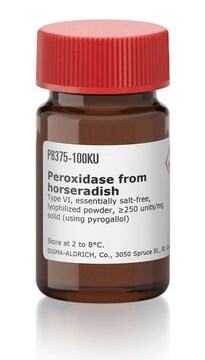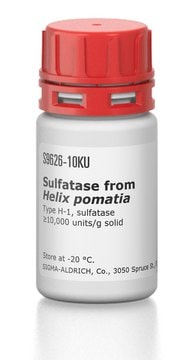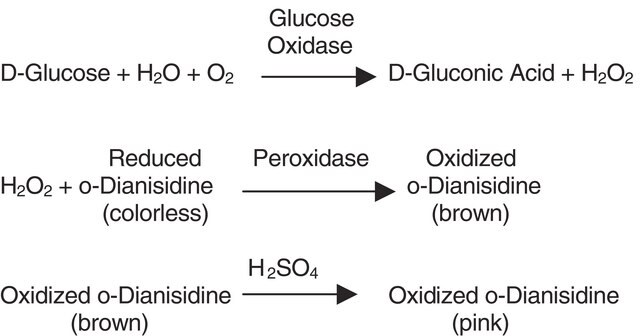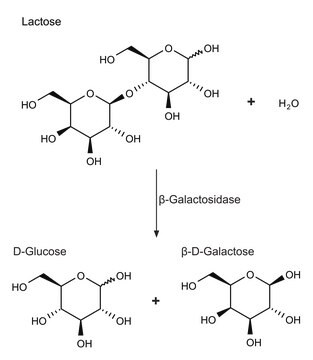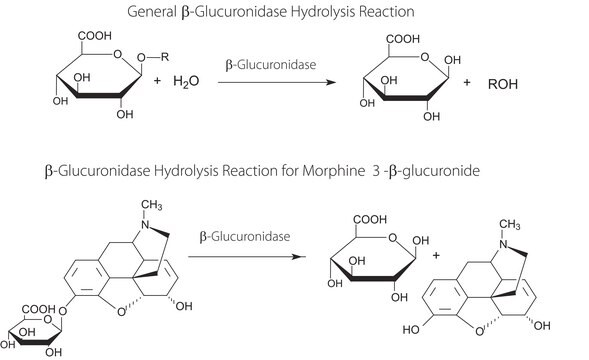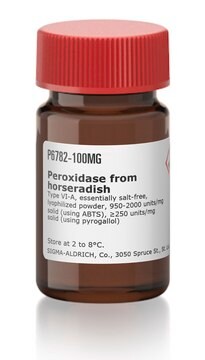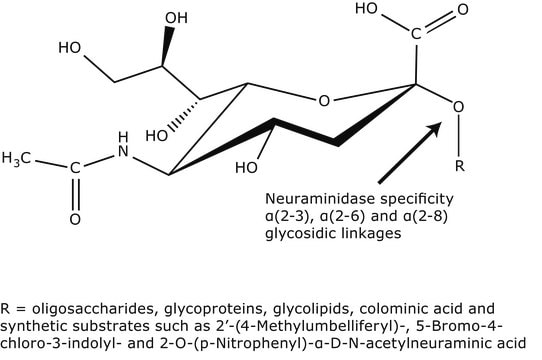G7907
Galactose Oxidase from Dactylium dendroides
≥30 units/mg solid
Synonyme(s) :
D-Galactose:oxygen 6-oxidoreductase
Se connecterpour consulter vos tarifs contractuels et ceux de votre entreprise/organisme
About This Item
Produits recommandés
Source biologique
fungus (Dactylium dendroides)
Niveau de qualité
Forme
lyophilized
Activité spécifique
≥30 units/mg solid
Température de stockage
−20°C
Vous recherchez des produits similaires ? Visite Guide de comparaison des produits
Description générale
Galactose oxidase is a member of radicalcoupled copper oxidases family. It is a fungal secretory enzyme.
Galactose oxidase is an extracellular copper-containing enzyme, secreted by the deuteromycete fungus Dactylium dendroides. It catalyzes the oxidation of a range of primary alcohols, including D-galactose, to the corresponding aldehyde, with reduction of oxygen to hydrogen peroxide.
Application
Galactose Oxidase from Dactylium dendroides has been used as a component for galactose oxidase treatment of arabinogalactan. It has also been used to co-immobilise with peroxidase for the preparation of a biosensor for galactose detection.
Galactose oxidase may be used as an analytical tool for the specific determination of D-galactose in blood plasma, plant extracts, and phospholipids. It could be used for the characterization of terminal D-galactoside units in several polymers. It may also be useful in the determination of lactose.
Actions biochimiques/physiologiques
Galactose oxidase catalyzes the coversion of D-galactose to D-galacto-hexodialdose.
2-Deoxy-D-galactose, lactose, melibiose, raffinose and stachyose react with galactose oxidase in the peroxidase:o-tolidine system.
Essentially no oxidation of D-glucose, L-galactose, L-arabinose or D-glucuronate has been observed.
2-Deoxy-D-galactose, lactose, melibiose, raffinose and stachyose react with galactose oxidase in the peroxidase:o-tolidine system.
Essentially no oxidation of D-glucose, L-galactose, L-arabinose or D-glucuronate has been observed.
Galactose oxidase has several applications in bioanalytics and histology. This free radical enzyme possess high substrate specificity.
Définition de l'unité
One unit will produce a ΔA425 of 1.0 per min at pH 6.0 at 25 °C, in a peroxidase and o-tolidine system. Reaction volume = 3.4 mL. Light path = 1 cm.
Forme physique
Lyophilized, contains buffer salts and stabilizer
Notes préparatoires
Chromatographically purified
Inhibiteur
Réf. du produit
Description
Tarif
Mention d'avertissement
Danger
Mentions de danger
Conseils de prudence
Classification des risques
Resp. Sens. 1
Code de la classe de stockage
11 - Combustible Solids
Classe de danger pour l'eau (WGK)
WGK 1
Point d'éclair (°F)
Not applicable
Point d'éclair (°C)
Not applicable
Faites votre choix parmi les versions les plus récentes :
Déjà en possession de ce produit ?
Retrouvez la documentation relative aux produits que vous avez récemment achetés dans la Bibliothèque de documents.
Les clients ont également consulté
Rapid and sensitive galactose oxidase-peroxidase biosensor for galactose detection with prolonged stability
Tkac J, et al.
BioTechnology: An Indian Journal, 13(12), 931-936 (1999)
Development of an immunoassay for larch arabinogalactan and its use in the detection of larch arabinogalactan in rat blood
Groman E V and Gou D
Carbohydrate Research, 301(1-2), 69-76 (1997)
Copper metalloenzymes
Comprehensive Natural Products II (2010)
M J McPherson et al.
The Journal of biological chemistry, 267(12), 8146-8152 (1992-04-25)
The gaoA gene, encoding the secreted copper-containing enzyme galactose oxidase, has been isolated from the Deuteromycete fungus Dactylium dendroides. Degenerate oligonucleotide primers were designed from amino acid sequence data for use in the polymerase chain reaction. A 1.4-kilobase DNA fragment
Takeshi Ito et al.
Talanta, 85(1), 707-712 (2011-06-08)
We proposed a low cost fabrication procedure of a poly(methylmethacrylate) (PMMA) column chip. 3D microchannel structure consisting of four columns in a chip for a mother die was fabricated using dry film photoresist and photolithography technique. Electroforming was applied to
Notre équipe de scientifiques dispose d'une expérience dans tous les secteurs de la recherche, notamment en sciences de la vie, science des matériaux, synthèse chimique, chromatographie, analyse et dans de nombreux autres domaines..
Contacter notre Service technique
